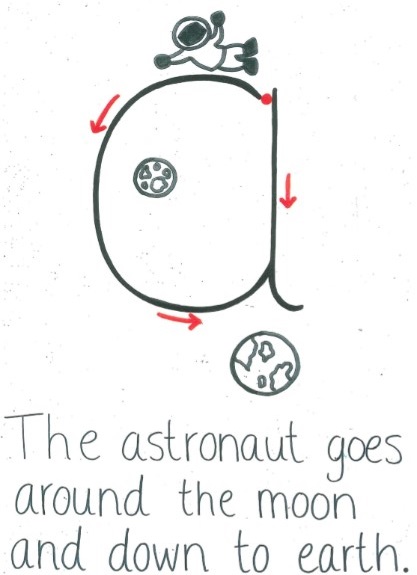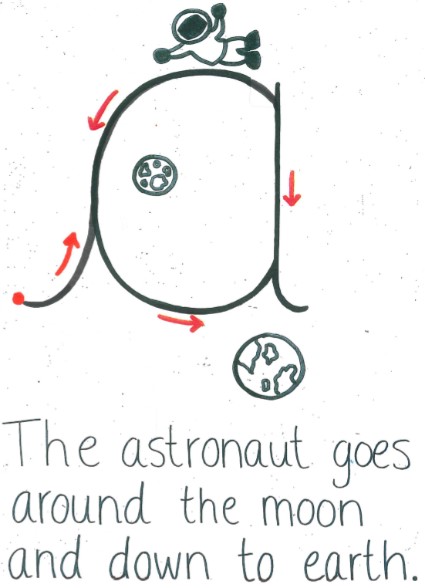Handwriting
Early Years
Fine Motor Development
This is an area of focus throughout the year. Children’s pencil grip and control is assessed through observation and their baseline unaided writing. This informs the provision that is put in place, for example, size of letters in their handwriting book or additional strengthening activities etc.
‘Funky Fingers’ activities are used in the Autumn term as ‘start of the day’ activities. These are set out on each of the tables for children to access when they come into school. There is always be at least one fine motor activity as part of each classroom’s continuous provision.
‘Dough Disco’ takes place daily in the Autumn term. This is a 10-minute whole class session when children use play doh to exercise their hands and strengthen their grip and control.
Handwriting
The initial focus is for children to be able to form the letters in their own name correctly. This is a ‘Spotlight’ focus in the Autumn term. The children are then taught explicitly how to form each letter using the correct formation during a weekly handwriting session. The formation of each letter is taught using a mnemonic which is a sentence explaining the shape of the letter. The letters are introduced in letter families to support the children in linking the formation of letters.
c,a,o,d,g, q, e, s, f
l, i, t, u, j, y
r, m, n, h, b, k, p
v, x, w, z
Handwriting is taught at the beginning of the week. It is recorded which children need further support with the formation of the letter being taught so that they can have further opportunities throughout the week to practise the formation. When a letter has been introduced in a handwriting session it is then expected that whenever the children are writing that letter it is formed correctly.
Handwriting phrases – introduced spring 2022 to Reception and will be used for the year 2 cohort of 2023-2024)
 a - The astronaut goes around the moon and down to earth
a - The astronaut goes around the moon and down to earth
b - The bouncy ball drops, goes up and around
c - The cat has a curly tail
d - The duck swims around the pond, jumps up out of the water and dives back in.
e - The elephant lifts its trunk and it spins around.
f - Feel the fish and draw on the fin.
g - The gorilla swings around the tree and under the branch.
h - Down the drain pipe and over the hedge.
i - Dip in the ink and draw on the dot
j - Scoop out the jam and dot on your toast.
k - The kite bobs down and up and around with the wind.
l - Down the lolly and give it a lick.
m - The mole digs down and makes two hills.
n - Nancy goes down and over the rainbow.
o - Around the otters face, starting at the ear.
p - The postman goes down the path and around the post-box.
q - The queen walks around the castle, down the red carpet and waves.
r - The rabbit jumps down and up and over the fence.
s - The snail is leaving a trail.
t - The tractor goes down the field and across the field.
u - You swim under the water, up for breath and back down you go.
v - The volcano bubbles deep down and erupts.
w - The worm wriggles down, up, down, up
x - X marks the spot.
y - The yoyo goes down up and spins around.
z - The zebra has three stripes.
Year 1
The children in year 1 will continue to develop their gross and fine motor skills. ‘Funky Fingers’ activities are still used in the Autumn term as ‘start of the day’ activities. These are set out on each of the tables for children to access when they come into school. After Christmas, these start of day activities move to focus on letter formation, number formation and cutting skills. For children who need it interventions are run to work on letter and number reversal or for children who need to exercise their hands and strengthen their grip and control.
 In Year 1, the children start the autumn term reviewing the printed version of each letter, following the letter formation they learnt in Early Years. At the start of the Spring term, the children will begin to learn a pre-cursive formation for each letter, based on the same letter formation they have previously learnt, only with each letter starting with a ‘whoosh’ and ending with a ‘flick’. (N.B Pre-cursive means that each letter will have an entry stroke, which we call a ‘whoosh’ and end with a flick.)
In Year 1, the children start the autumn term reviewing the printed version of each letter, following the letter formation they learnt in Early Years. At the start of the Spring term, the children will begin to learn a pre-cursive formation for each letter, based on the same letter formation they have previously learnt, only with each letter starting with a ‘whoosh’ and ending with a ‘flick’. (N.B Pre-cursive means that each letter will have an entry stroke, which we call a ‘whoosh’ and end with a flick.)
In the autumn term handwriting is taught two to three times a week and is on offer as an activity daily during Active Learning Time. The children will have adult led sessions at least twice a week. Children will also have the opportunity to independently practise their handwriting through different mediums, for example, graffiti paper, chalk or water on the playground, paint, writing in sand and rice and writing with pencil on lines. In the spring term the children will take part in twice-weekly adult led sessions where they will learn how to form two to three letters per week by writing in books and on lines.
Year 2
In Year 2, the children start the autumn term reviewing the pre-cursive letter formation that they learnt in year 1. Depending on the stage the children are at, the class teacher will make the decision on when to begin teaching the continuous cursive joins. Each lower case letter will have an entry stroke, also known as a ‘whoosh’. When a single letter is joined on to another single letter, this is called a hook not a flick, as the flick now acts as a hook on to the next letter.
In Year 1 and 2 we follow the ‘Teach Handwriting’ scheme. The online platform has useful videos that we use in class, when reviewing pre-cursive letter formation, and for teaching the continuous cursive joins. The joins are taught in a systematic and logical way. For example, the first joins taught are called ‘bottom joins’ (the letter is joined from the bottom of the letter). These include as, av, and aw.

The children start the week with a teacher led session, teaching them how to form their pre-cursive or continuous cursive script. The children will then continue to practise their newly taught joins. Once all joins are learned, the children will move onto practising words in a cursive style. At the discretion of the teacher, a decision is made as to when children can implement their cursive style into their day-to-day writing.
Key Stage 2
In all key stage 2 classes, children will continue to practise their cursive handwriting, through sessions and in their written work. In years 3 and 4, cursive handwriting is consolidated through teacher led sessions. In Year 5 and 6 children use a pen for all written tasks.
Any children who find handwriting challenging will be part of a handwriting group, this may entail, strengthening their fine motor skills, through daily activities and/or have interventions to further practise and develop their letter formation.
